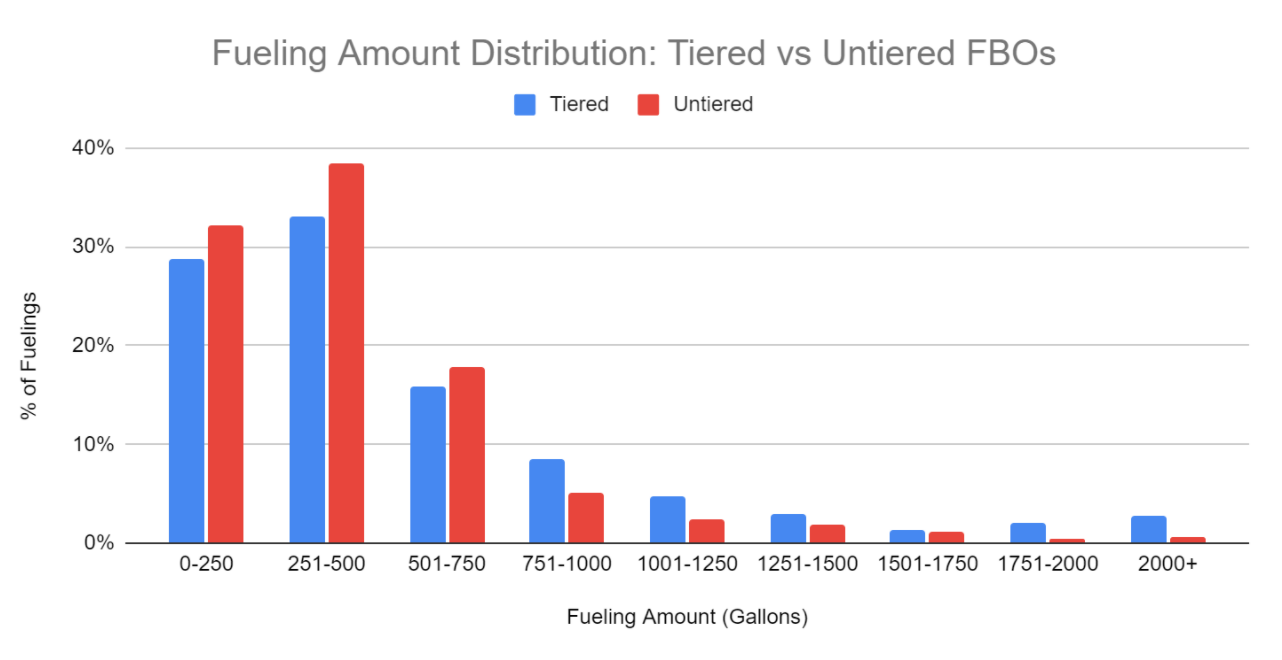How Tiered Pricing Influences Fuel Purchasing
To tier, or not to tier? That is the question we know many of our Preferred FBO partners wrestle with when developing their fuel pricing strategy. Fly Louie is uniquely positioned to deliver some potential answers. Since launching the Fly Louie Alliance in 2019, our team has had line of sight into the effects of tiered pricing on operators’ purchasing behaviors across 1,500 tails. The insights we generate from that data help us to create value for our Alliance members, and new business opportunities for our FBO partners.
Fly Louie recently completed an analysis on the effects of tiered pricing on 175 operators’ purchasing behavior in the popular Alliance Fuel program. Enrollees in the program save up to $.89 per gallon on fuel purchases at 50+ participating FBOs. We’re pleased to share the results of our analysis with our members and other interested FBOs and operators.
Takeaway #1: Operators are more likely to purchase higher amounts of fuel at FBOs with tiered pricing.
The chart below shows that tiers above 750 gallons tend to see a higher frequency of fuelings among tiered FBOs than among non-tiered FBOs (blue bars higher than red bars), while the opposite is true for tiers below 750 gallons
In fact, the average uplift for tiered FBOs is 579 gallons, 29% higher than the non-tiered FBO average of 450 gallons. (Average distance for flights into tiered FBOs and non-tiered FBOs is roughly the same.)
Source: Fly Louie Alliance Advisory Fuel Report, February 2021
Takeaway #2: Operators tend to “top up” at tiered FBOs when they’re close to a tier, resulting in higher fueling volumes
The blue bars in the chart below show the frequency of fuelings for tiered FBOs, organized by distance from tiers. For example, for an FBO with a price tier at 500 gallons, the blue bars show how often operators fuel just above 500 gallons, just below 500 gallons, and a few additional intervals as well
In order to compare that data to non-tiered FBOs, the red bars suppose that non-tiered FBOs have a hypothetical tier at 500 gallons and outline the distribution of fuelings around that hypothetical tier. Unsurprisingly, the hypothetical tier has zero impact on fueling distribution (we see a consistent downward trend of the red bars as we move to the right)
Comparing blue to red, we see the impact that tiers have on fuel volume. Most notably, we see 8 points of differential between tiered and non-tiered FBOs in the 50 gallon interval just below a tier, suggesting that a tier has a positive impact on fuel volume roughly 8% of the time.
Source: Fly Louie Alliance Advisory Fuel Report, February 2021
Fly Louie would be happy to discuss this analysis in more detail with any Alliance Preferred FBO that’s interested, including those who don’t currently have tiering with Fly Louie. Similarly, if you’d like to learn more about becoming a Fly Louie Alliance Preferred FBO, our team would be excited to discuss the opportunity to be part of our Alliance Fuel program. Please reach out to us at fuel@flylouie.com, or schedule time to talk to a member of our team: Pick a Time.


